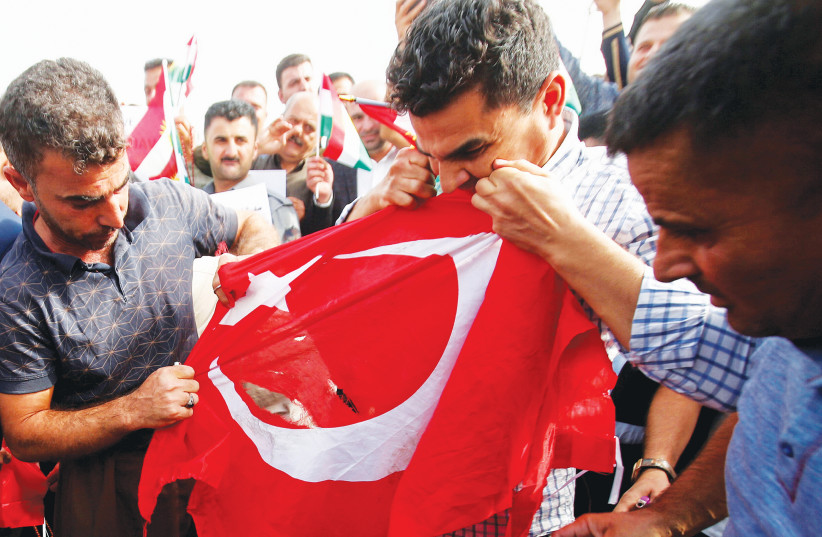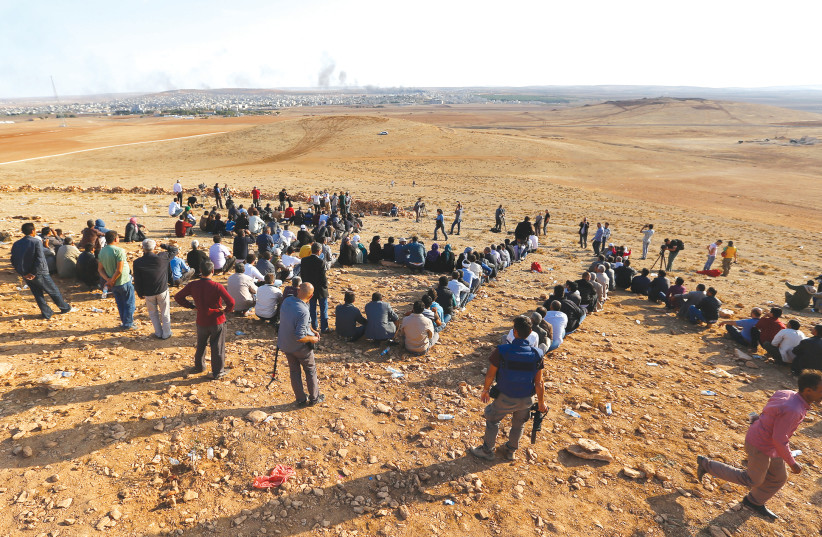Iran and Turkey are both threatening invasions of areas where Kurdish people live in Iraq and Syria.

Iran and Turkey are both threatening invasions of areas where Kurdish people live in Iraq and Syria.
Turkey has already sent forces into parts of northern Iraq over the years and occupies several Kurdish areas of Syria, and Iran has been carrying out drone and missile attacks on Kurdish opposition groups who have camps in Iraq. However, both authoritarian regimes have now increased threats to launch new ground incursions that could cause hundreds of thousands of people to be displaced.
Are Iran and Turkey coordinating their efforts to destabilize Syria and Iraq and attack areas in both countries?
While Iran and Turkey sometimes appear to be on different sides of conflicts in the region, they share some common interests. Iran and Turkey both have regimes dominated by far-right religious parties: In Iran’s case, it is a theocratic regime that dates from 1979, and in Turkey, it is the AKP party that rose to power in the early 2000s.
These religious leaders share some policies in the region. They both back the Hamas terrorist group; they have both opposed Israel, although Turkey and Israel recently reconciled; both Ankara and Tehran also view themselves as opponents of US policy in Iraq and Syria; both Iran and Turkey also work with Russia on the “Astana process” regarding Syria. This process is designed to end the Syrian civil war, but it is also designed to give Iran and Turkey influence over a swath of Syria.

Iran and Turkey both claim they are not against Kurds as a group. Iran claims it is fighting opposition groups. There are large Kurdish minorities numbering many millions in Turkey and Iran, as well as in Syria and Iraq. In Syria, the Kurdish People’s Protection Units (YPG) form a key part of the US-backed Syrian Democratic Forces, and Kurds in Syria played a key role in the defeat of ISIS. However, Ankara accuses the YPG of being part of the Kurdistan Workers Party (PKK) which Ankara claims is a “terrorist” organization.
Ankara often claims the PKK is behind attacks in order to justify its invasions of Syria. For Ankara then the existence of a Kurdish group playing a key role in eastern Syria is the reason that Ankara wants to invade. Turkey has already illustrated its policy goals via the invasion of Afrin, a Kurdish area that it invaded in 2018, and then it used Syrian rebel groups to ethnically cleanse Kurds. After having removed most of the Kurds from Afrin, Ankara invited other Syrians to settle in Afrin, creating demographic change like in the 1990s in the Balkans.
Ankara’s overall goal is to settle Arabs along the border and remove Kurds from cities like Kobani, Qamishli and others, as it did in Afrin. Turkey calls this a “safe zone,” removing ethnic minorities to create a pro-Ankara belt of colonies along the border. If this reminds people of the 19th or 20th-century policies of colonial powers and extremists, it is because it is modeled on that era.
Iran’s policy is a bit different
Iran doesn’t seek to ethnically-cleanse Kurds from Iraq or Iran. Iran doesn’t have the military power or extremist groups it can mobilize to do ethnic cleansing, nor is it a member of NATO.
Turkey’s membership of NATO gives it control over other NATO countries for its policies in Syria. For instance, Turkey had threatened to veto Sweden and Finland from joining NATO unless they back its occupation of Syria.
Iran is also a poorer country than Turkey and it can only resort to influence peddling and the use of rockets and drones to carry out its policies. However, Iran’s overall policies also target Kurdish groups in northeastern Iran and Iraq. Turkey’s enemy is the PKK, but Iran’s enemy or groups such as PDKI, Komala and PAK. That means that ostensibly Iran and Turkey do not oppose the same Kurdish groups, however, the overall policy is the same.
Iran is seeking to change the situation in part of northern Iraq along the border with Iran, while Turkey is seeking to do the same in Syria. Iran wants to weaken the Kurdistan Regional Government, an autonomous region in Iraq. The KRG is a successful economic region and also has its own security forces. But like eastern Syria, the Kurds of Erbil in northern Iraq don’t have air defenses to stop Iran’s missiles. The Kurds in eastern Syria also lack any defenses.
The US forces in eastern Syria have not sought to stop Ankara’s bombing of Kurdish forces, even when Turkey carries out airstrikes on areas where US forces are located nearby. In the last week, Turkey has targeted Kurdish forces who are training with US forces.
A France24 article last week examined the policies of Turkey and Iran as targeting Kurds as “scapegoats.” It’s unclear if in both cases the regional powers of Ankara and Tehran see Kurds merely as scapegoats. Turkey has a policy in Syria whose agenda is to remove the US. Iran also wants the US to leave Syria and Iraq. In this essence, Turkey and Iran are attacking Kurds in part because they want to attack the US but don’t want a direct conflict with Washington. This means that civilians pay the price for larger policies of Ankara and Tehran.
On the other hand, Iran wants to neutralize Kurdish opposition groups because Tehran is facing protests at home. Tehran is afraid of minority groups, and it is easier to target minorities with missiles than attack Persian Iranians.
Turkey’s decision to launch a new invasion of Syria may be related to elections next year. But it is also related to a long-term Ankara goal of taking over more of the border region of Syria to move Syrian refugees from Turkey into this area and remove Kurds from the border. This old-style ethnic cleansing, similar to the 20th-century policies of the Soviet Union or fascist countries, is designed to create a “loyal” buffer zone of communities along the border that Ankara can use as proxies.
Therefore the Ankara and Tehran policies are different in this respect. Tehran wants to send a message to the KRG and Iraq to crack down on Kurdish opposition groups. It wants to neutralize PDKI, PAK and Komala using missiles to stop them from supporting the protests.
Turkey’s goal is more wide-ranging as it wants to displace hundreds of thousands of people to recreate the entirety of northern Syria, erasing a thousand or more years of human history and diversity in that region that stretches from Afrin to Qamishli. This erasure targets not only Kurds but also Yazidis, Christians and other groups. This is the same reason Turkey continues to bomb the Yazidi area of Sinjar, an area targeted for genocide by ISIS.
Ankara’s wider goal goes back to the foundation of modern Turkey. When the Ottoman Empire collapsed, modern Turkey emerged amidst the persecution of Armenians, Greeks, Kurds and other groups such as Assyrians and other Christians. Ankara later invaded Cyprus and displaced Greeks in the north.
The invasion of Afrin and threats to invade Kobani are thus part of a much longer cycle designed to reduce the presence of minorities. Iran’s policy is more complex. Tehran knows that the majority of Iranians are members of minority groups. It needs them as part of Iran, so its goal is to stop opposition groups from growing, not displace whole groups of people.
Iran and Turkey have common interests. They want the US’s role in the Middle East to be reduced. Both of them back Hamas and other extremist groups. The Kurds are scapegoated by both regimes and whenever the regimes want to use their military to attack someone they tend to attack Kurds because they know that the Kurdish minority doesn’t have strong backing.
Ankara and Tehran were displeased to see the strength of the autonomous regions of the KRG in Iraq and eastern Syria flourish. However, both countries have interests in these regions. Iran and the Syrian regime generally didn’t have a problem with the YPG, whereas Ankara has backed the KRG. That means it is not a simple anti-Kurdish policy that unites Iran and Turkey.
The real policy is designed to get rid of the US, and the other policy is Turkey’s desire to change the demographics of the border and Iran’s goal of weakening opposition groups. Coordination in this respect is operationalized via the Astana process in Syria, and work with Russia. Both Iran and Turkey work closely with Russia.
Turkey wants to be an energy hub partnering with Moscow, and Iran is selling Moscow drones. Economics ties Turkey and Iran to Moscow. In this respect, they have a common policy, but not necessarily a policy that is solely anti-Kurdish. The end result is that Kurds are victims and pay the price for the Ankara-Tehran partnership.
Content retrieved from: https://www.jpost.com/middle-east/article-723437.